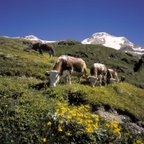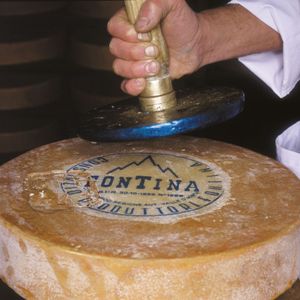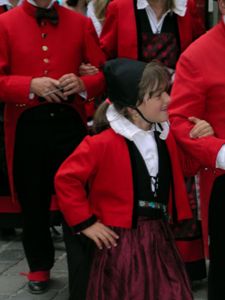Special Feature: Products Sally Recommends
Sampling Valle d'Aosta's Sky-High Italian Cuisine
 Nestled in the northwestern corner of Italy, the Valle d’Aosta is best known for easy access to world-class ski slopes and the Mont Blanc tunnel. Too bad, because this smallest of Italian regions has much more to offer: spectacular scenery, towns rich in history and charm, extensive hiking trails and parklands.
Nestled in the northwestern corner of Italy, the Valle d’Aosta is best known for easy access to world-class ski slopes and the Mont Blanc tunnel. Too bad, because this smallest of Italian regions has much more to offer: spectacular scenery, towns rich in history and charm, extensive hiking trails and parklands.
There are also amazing foods and wines to discover, at prices that seem reasonable even in this era of the shrinking dollar.
The Valle d’Aosta has always steered its own course. Separated from the rest of Italy by mountainous terrain and ruled for centuries by the princes of Savoy, the valdostani took the best from French and Northern Italian traditions to create a distinctive mountain cuisine based on superb cheeses, beef and game, root vegetables and wines.
Two friends and I began a three-day tour last July with a brisk hike in the Valpelline, part of the region’s network of trails for hikers of all abilities. It’s known for high pastures and abundant wildflowers admired by hikers and nibbled by athletic dairy cows, who climb to ever higher elevations as summer progresses. Their milk is reserved for the region’s famous washed-rind cheese, Fontina Valle d’Aosta.
Setting out just below the highest pastures, at about 7,000 feet, we followed a ridged trail carved out by cow hooves, not humans.
With the help of a wildflower guidebook, we identified white yarrow blossoms, blue gentian, rock-clinging rhododendrons and dark-red “vanilla orchids,” one of 10 orchid varieties found in these parts. Genepy grows in the highest moraines but wouldn’t be blooming until August, when it is gathered to make a sweet yellow liqueur that goes by the same name.
On the way down, we drove past the Conca de By, a shell-shaped meadow where farmers bring their most exceptional cows to compete in the “Battle of the Queens” (www.amisdesreines.it). Attended by thousands, the October contest is Valle d’Aosta’s answer to Spain’s macho bull-fighting tradition.
 Next stop: the Milk and Fontina Cheese Producers Cooperative, where white-jacketed cheese steward Ivo guided us through a tasting, our favorites a three-month Fontina redolent of toasted hazelnuts and a longer-aged, deeply savory one.
Next stop: the Milk and Fontina Cheese Producers Cooperative, where white-jacketed cheese steward Ivo guided us through a tasting, our favorites a three-month Fontina redolent of toasted hazelnuts and a longer-aged, deeply savory one.
Walking through a vast, pleasantly cool cave where the cheeses age (once a copper mine), Ivo showed how to tap a wheel, listening for the deep thrum signaling that all is proceeding well. Though authentic Fontina is widely available in the U.S., there’s no better place to buy it than here, shrink wrapped and ready for the flight back home.
A light lunch of cured meats and salad at La Jolie Bergere, a rustic mountainside place, ended with a passing of the coppa d’amicizia. This is really a winter ritual and, truth be told, more for tourists than the natives. But the staff humored us, filling the hand-carved “friendship cup” with a warm, potent coffee-grappa concoction and flaming it at the table.
After drinking from one spout, each drinker politely rotates the vessel, offering an untouched spout to the next person. Or at least that’s how the first round proceeds. As we discovered, a certain giddiness tends to set in and before long any spout will do.
In the kitchen of Les Vieux Alpages, an agriturismo with spectacular views of mountains and cheese-making sheds, we walked into the intoxicating aroma of carbonada, a beef stew dosed generously with red wine. Corinne, chef and owner, invited us to watch her assemble the region’s most famous dish, seupa valpellinentze, a robust casserole built with Fontina, dark bread and, normally, cabbage—Corinne’s little twist is to substitute cabbage broth, with the leaves strained out.
 We admired the panoramic rainbow that followed a drizzle and then it was time to feast on waves of food from Corinne’s kitchen, among them vegetable-filled crepes and airy fritters flavored with mint and sage. Wearied by a day of vigorous exercise and equally vigorous dining, we slept soundly in the dead quiet of this mountain retreat.
We admired the panoramic rainbow that followed a drizzle and then it was time to feast on waves of food from Corinne’s kitchen, among them vegetable-filled crepes and airy fritters flavored with mint and sage. Wearied by a day of vigorous exercise and equally vigorous dining, we slept soundly in the dead quiet of this mountain retreat.
Day Two began with a visit to Salumificio Maison Bertolin, a producer of gourmet cured meats located just off S.S. 26, the main road running from Aosta to Milan. We tasted a dozen salamis, sausages and other cured meats made from pigs, cows and, uh, donkeys.
The most spectacular was lardo d’Arnad: pork belly layered with salt, mountain herbs and garlic, then aged in wood for at least three months. Basically bacon, but bacon for the gods, silky and sensuous.
Ignoring Otto von Bismarck’s quip that “to retain respect for sausages and laws, one must not watch them in the making, “ the Bertolin family invites visitors to observe production of its cured meats through glass. Also sold here are excellent regional products such as wines, walnut oil, dried chestnuts and hand-carved wooden objects, including the coppa d’amicizia in various sizes.
After savoring frescos of medieval banquets at the Castle of Issogne, we were ready to eat again, this time at Maison Rosset, an agriturismo located, atypically, in a town. “These days, chic people are coming to authentic places like this, not a glitzy hotel in Courmayeur,” said Elisabetta Converso, our guide. The dishes I won’t forget: salt-marinated beef cooked in a wood-burning stove and served with a piquant green sauce, organic vegetables from the owners’ garden and gelato churned from high-pasture milk.
Among the many charms of Aosta, the region’s capital, can be counted the criptoportico, a majestic underground tunnel that stays cool even on the hottest days. Did the Romans build it for security or as an indoor public forum? No one is sure, but as a peaceful place for post-prandial wandering, it’s hard to beat. We emerged to find the streets in a state of happy confusion, with a feast-day procession of inhabitants in colorful folk costumes.
Vecchia Aosta, in the shadow of the ancient Roman gate called Porta Praetoria, has been a restaurant of sorts for two hundred years. It deserves to survive for couple more centuries, judging from my appetizer, a radicchio salad topped with creamy potatoes and fork-tender octopus. This is a good place to sample some of Aosta’s superb red wines, made from indigenous grapes such as petit rouge and fumin, or a white such as Petite Arvine DOC, with a floral scent and fruity flavor. Dazzling desserts like flaky sfogliatelle and vanilla ice cream, sitting in a pool of dark chocolate, reminded us we weren’t far from France.
On our last day, we soared above the mountain trails we’d hiked earlier. That is to say, we took the Mont Blanc funicular to the top and crossed the glacier to the peak overlooking Chamonix, gazing down at insect-sized hikers picking their way past slit-like acquamarine lakes and gaping crevasses. Even in mid-summer, woolen hats and mittens are de rigueur and by the time we descended to Ristorante Pavillon, one gondola ride from the bottom, the hearty fare on offer was just what we wanted.
I started with the Monte Bianco salad, an extravaganza of greens, fresh tomatoes, Fontina, pickled onions, whole-wheat croutons and crisped bacon. My friend Nancy ordered polenta concia, a porridge of buckwheat polenta laced with melting chunks of Fontina—so good the rest of us kept sneaking our spoons into her bowl.
The Valle d’Aosta is known for game, so we ordered venison braised in Torrette wine with sautéed mixed mushrooms. Chatting with manager Andrea Betti, we were startled to learn that this superb restaurant is operated by the funicular authority—a bit like discovering that Amtrak has snagged a Michelin star.
At dusk we stopped at Cantina Di Barrò, on the road between Courmayeur and Aosta. Andrea Barraz and his wife Elvira Stefania Rini invited us in for a tasting at a long wooden table. As with other small wine producers, all but about 10 percent of their production is drunk right here in the Valle d’Aosta. A “wine trail” organized with other small producers is taking shape and, in the meantime, the couple is happy to give a tour and tasting to visitors who call ahead.
As we chatted with Andrea and Elvira, sipping their full-bodied Torrette wine with a fine Fontina and chestnut-studded black bread, it occurred to me that this would be our final meal in the Valle d’Aosta—at least for now. I couldn’t think of a better ending to a delicious trip.
When You Go…
Dining
(prices are for a typical 3- or 4-course meal)
Les Vieux Alpages, loc. Vorbé Doues, 0165.738025; 347.7313358;18 euros, without wine
Vecchia Aosta, address, Aosta; phone; www.vecchiaosta.it; 35-50 euros, with wine
Ristorante Pavillon, Courmayeur; 0165.844090; www.montebianco.com; 35 euros, with wine
La Jolie Bergère, Loc. Planaval; 0165.861292; 18-26 euros, without drinks
Agriturismo Maison Rosset, v. Risorgimento, 39, Nus; 0165.767176; www.maisonrosset.it; maison.rosset@libero.it; 25 euros
Tastings
Fontina Milk and Cheese Producers Cooperative, Loc. Croix Noire; 0165.35714; www.fontinacoop.com
Salumificio Maison Bertolin (cured meats), Arnad; 0125 966127; info@bertolin.com
Route des Vins (Wine Trail), 0165 275215; www.regione.vda.it/agricoltura/vini/cartina.asp
Di Barrò, Loc. Château Feuillet, 8; 3332935049; dibarro@vievini.it
Resources
General information: www.regione.vda.it; hiking trail maps and itineraries, /altevie; Wine Trail, /agricoltura/vini/cartina.asp
Guide: Elisabetta Converso, guideservice.vda@tele2.it, 0165.80.99.81
![]()
Toni Lydecker writes often on Italian cooking and is the author of Serves One: Meals to Savor When You’re on Your Own. For more of her writing, visit www.tonilydecker.com.
Note: This information was accurate when it was published. Please be sure to confirm all rates and details directly with the businesses in question before making your plans.



